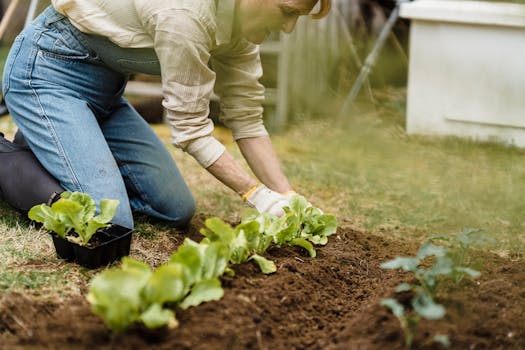These tomato growing tips and instructions on how to grow tomatoes will guarantee fruits that get your taste buds tingling with delight. But… believe it or not, it is only in the last 70-80 years that growing tomatoes has become universally popular. Understandable… walk into a tomato garden (greenhouse) full of ripe tomatoes mmmm – beats having to buy tomatoes that are picked unripe and tasteless.
Tomatoes arrived from S. America (into Europe) about four centuries ago but were largely regarded as decorative, flowing trusses of brightly coloured flowers and fruit – AND dangerous. Who wouldn’t… a member of the deadly nightshade family I think I’d be more than tempted not to learn how to grow tomatoes if I had not seen them before.
I can only imagine that the fear of eating tomatoes was only overcome when people who schemed to ‘bump’ off their enemies, by mixing them in their food, were flourishing and not fading – that’s purely my theory folks so don’t quote it… you’ll only get laughed at.
But while the tomato has become more popular its quality has sadly declined and the reason is its commercialisation. The commercial grower has learnt how to grow tomatoes which crop heavily and will travel well to the supermarket at the expense of taste.
The great news is that we amateurs can still learn how to grow tomatoes that are bursting with flavour… there is nothing I enjoy more (don’t take that too literally) than picking a ripe tomato straight off the vine and popping it into my mouth, yep I don’t even stop to wash it.
Anyone who can provide a reasonable amount of sun can learn how to grow tomatoes – with or without a garden. In cooler climates – in the north of Britain for example – planting tomatoes outdoors is a gamble but using cloches, polly tunnels or greenhouses make it all possible.
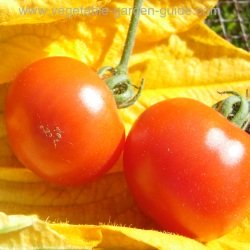
Do you want to expand your vegetable growing experiences? – you can!… grow or start your vegetables off under cover. See a great selection of protection covers by clicking on one or more of the links below to one of our preferred suppliers:
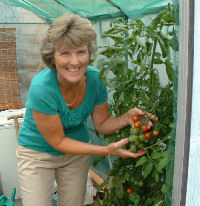
So let’s dig in… as our new neighbours did. Dave and Paula moved next door at the back end of 2005. In early spring I offered them some spare tomato plants I had over as they had inherited a greenhouse. “But we’ve never grown them before”, was their reply. So I encouraged them to get a Growbag – a peat free one was purchased.
I prepared the Growbag as above and it was placed on a gravel surface in their greenhouse. In went the tomatoes and with a few instructions Dave and Paula nurtured their crop through the summer, the flowers appeared, fruit developed and, well the photo tells you how successful they were… that’s Paula – Dave said he was too photogenic to be in it and didn’t want to eclipse Paula.
How to Grow Tomatoes Under Glass – Soil Details
Under glass (in a greenhouse or polytunnel), tomatoes can be grown in the border soil – if the bed can be raised and more soil added by reinforcing the sides with planks of wood, even better, this will give a more superior result.
Prepare the soil during winter – incidentally this is also the time you can give your greenhouse a good scrubbing and disinfecting, a cleanish environment is best when learning how to grow tomatoes under glass… I find an old toilet brush does a great job. Hose down to finish off.
Sorry for that aside… dig in some well rotted compost or manure as tomatoes like a fairly rich water retaining soil, pH6.5-7.00. Apply lime if necessary. Two or three weeks before planting apply a general fertilizer like Growmore and rake in.
There is one drawback with planting tomatoes directly into the border soil, if you want to learn how to grow tomatoes successfully it is essential you know what it is. Unfortunately the soil soon becomes infested with soil pests and diseases.
This gives you the headache of having to either sterilise the soil – not easy or practicable from the amateurs position – or to change the soil every couple of years – but do not despair…
Because pest and disease do build-up, other methods of cultivation have evolved. The two most popular methods for learning how to grow tomatoes are set out below.
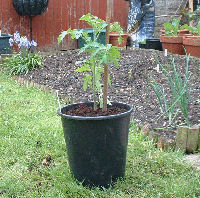
Growing tomatoes in 23cm(9″) pots – ensure the pots have drainage holes in the bottom and fill to just below the top with soil less potting compost or better still, fill half and half with a loam based compost and potting compost – this will help retain water better. You can of course use your own well rotted compost to mix with the potting compost. Do this in advance of planting the tomatoes to allow the compost to settle and warm up… don’t let it dry out.
Place your pots in the greenhouse 45cm(18″) apart either on a hard surface of if the borders contain soil then sink the pots into the soil 8-10cm(3-4″) deep with a layer of sand or gravel under their bottoms for drainage.
Pests and diseases from the soil shouldn’t be a problem as you will only use the compost for one season. Three bits of advice – this concerns all approaches to learning how to grow vegetables – experiment, experiment, observe.
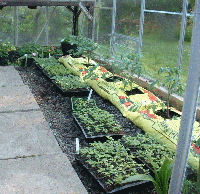
Planting tomatoes in Growbags – the most popular method of cultivation and I never use any other way. Growbags are plastic bags filled with a prepared soil less(peat) compost or peat free compost containing enough nutrients for the growing tomato plant to develop its first truss. A soluble fertilizer will then need to be watered in once a week during the growing season – this applies to tomatoes grown in the border soil and the plastic pots.
One potential drawback with Growbags is getting the watering right. Too much and it will keep the roots sitting in the water affecting the plants development, too little and the compost dries out. The plant will soon wilt and re-wetting the compost will be difficult – take note of this point and add it to your knowledge on how to grow tomatoes, it is important.
When peat dries out it becomes ‘waterproof’, so when watering the top it may look wet but in its middle it may still be very dry. So the dilemma is that regular watering is required but not too much to water-log the roots.
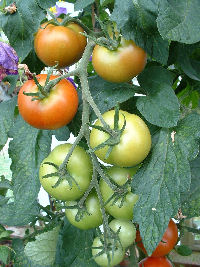
This is my answer to the problem and I have proved it adequate from experimenting over a number of years, my greenhouse borders contain soil which I have not changed for fifteen years (see my healthy tomatoes left for 2006). I take a Growbag and with a sharp knife cut a slit in its underside 8cm(3″) wide, along about 2/3 of its length.
I then very carefully turn the bag over onto its underside (at this point the contents are in danger of spilling out – be careful) over the place I have prepared in the soil border of the greenhouse.
Preparation of my border soil just means breaking the surface down to a reasonable tilth, applying a general fertilizer like Growmore and watering well. I grow no more than two tomato plants per bag. The slit allows free drainage into the soil below, the tap root of the tomato plant can penetrate into the soil so if the bag dries out a little (not recommended) it is still getting a drink.
The fine feeding roots remain in the compost of the Growbag ready to feast on that potash-rich liquid fertilizer you will keep feeding them once a week.
Since teaching myself how to grow tomatoes in this way I have never had a problem with soil born pests or diseases and I can’t tell you why not, but this works for me. Remember, experiment, experiment, observe. If you only have a hard surface to place the Growbags onto then one answer is to use two Growbags, one on top of the other. Prepare both bags as above but in addition also make a wide slit into the top of the lower bag. Make a planting hole no deeper than to the top of the lower bag.
How to Grow Tomatoes – Sowing and Planting
Tomatoes need warmth and light. Earlier crops can be sown in a heated greenhouse keeping a minimum night temperature of approximately 13C(55F). Sow seeds in late December, plant out into their final positions by late February or early March. Harvesting should begin in May or June.
This is an expensive way to learn how to grow tomatoes and is time consuming in terms of energy input i.e. gas or electricity, insulation, and monitoring the ventilation. But… if your Mr or Mrs Moneybags then give it a go.
For gardeners like you and me, knowing how to grow tomatoes at minimum cost is advisable – so we let nature provide all the light and heat that we need. Sow tomato seed in an unheated greenhouse in early April for planting out in May.
You can bring this forward by three weeks by raising your seedlings inside an electric propagating frame either built into your greenhouse or one that you can purchase from a garden centre or DIY store.
I built mine (photo on left) about 20 years ago and I find it invaluable for raising seedlings and for rooting cuttings at a relatively low running cost.
Another way of providing tomato plants is to purchase seedling plants from a reputable supplier. This is very cheap to do if you only need a few… but it is important that you trust where you are getting them as you may introduce disease. If in doubt ask about their origin.
How to Grow Tomatoes – Sowing Seed
There are two ways you can sow tomato seed:
If you require lots of tomato plants then sow your seed into trays. I grow mine in 21cm(8″) trays which is more than adequate to germinate all the tomato seed I need – don’t forget…
Pass any extra on to your neighbours maybe.
I purchase these trays from my local garden centres and they last for years. Make sure you wash and sterilise your pots and trays before use to keep pests and diseases at bay. Ask your garden centre what to use when purchasing your trays.
When learning how to grow tomatoes from seed, or any plant – then it is best to follow conventional techniques.
- Fill the tray to overflowing with Seed and Cutting Compost (from Garden Centre) ensuring you have left no air spaces and that the compost is well into the corners but not pressed down hard.Make a piece of wood that spans the width of the tray and push it along the top skimming off the excess compost. You should be left with a tray full to the top with compost.
- Find or make from a piece of wood 6mm(1/4″) thick a rectangle that will just sit inside the internal dimensions of the tray. Use this to press down the compost in the tray – not too hard – until it is about 6mm(1/4″) below the top of the tray.This will now give you a nice clean and even surface to sow your tomato seed onto. Who said learning how to grow tomatoes wasn’t an art form!
- Sprinkle your seed evenly onto the surface but don’t overcrowd. If you can, make or purchase a fine-ish sieve into which place some compost and sieve it evenly over the seeds – this places a fine layer of compost over the tomato seeds.
- Don’t water from the top; you’ll probably destroy your hard work. Instead get a large plastic tray – I use a cat litter tray – half fill with water and place the seed tray into the water… making sure it is not overflowing the top. The compost will now absorb the water from below.You will know when it is ready as the top of the compost will be very wet. Remove and place it where you intend the seeds to germinate and remember to keep the compost moist. They will require a temperature of approximately 18C(65F) – remember also, don’t be afraid to experiment… you may get away with lower temperatures.
How to Grow Tomatoes – Pricking Out
Tomato seeds take about 8 days to germinate after which the seed leaves begin to emerge. The seed leaves are the first two leaves on the plant and they will look different from all the others that will eventually appear as the plant grows.

Don’t feel embarrassed if you start getting excited at this point – you haven’t been learning how to grow tomatoes because it’s boring.
When the leaves are fully expanded prick them out by carefully taking hold of a seed leaf (not the stem – ever) between thumb and index finger and plant into a 10cm(4″) pot or modular trays that have been filled with Potting Compost (from Garden Centres). Gently press the compost down around the roots.

A great tip when learning how to grow tomatoes – as the plant is being pricked out and planted into the pots or trays, insert the seedling tomato plant into the new compost so that the seed leaves are just above the compost. This encourages more roots to grow from the tomato plants stem. You will do this again when planting into their final growing place.
If you require just a few tomato plants then sow a couple of tomato seeds per 10cm(4″) pot and remove the weaker seedling after germination. Just by knowing how to grow tomatoes using this method you will omit the pricking out stage.
The phrase ‘pricking out’ mentioned above refers to the action of transferring seedlings from the tray to the individual pots where the tomato plants can grow and gain vigour – ready for final transplanting to their growing position.
How to Grow Tomatoes – Planting out
As I stated earlier, I grow my tomatoes only in Growbags and that is what I will describe here but it will essentially be the same for planting out into the border soil or into the 23cm(9″) pots as well.

Plant tomatoes into Growbags in early May if you sowed your seed in a heated propagator during mid March, or plant out in late May if you sowed your seed during early April in a cold greenhouse.
I know I keep saying this but it is a mantra to keep in mind – experiment and observe – instructions on how to grow tomatoes are guidelines… sowing and planting times are flexible within reason.
Seedlings need to be approximately 15-20cm(6-8″) tall with the flowers of the first truss beginning to show. Water the pot containing the seedling thoroughly before transplanting.
Remember, I only grow two plants per bag so cut two 8cm(3″) squares into the top of the Growbag so that the plants are positioned 45cm(18″) apart at equal distances from the centre of the bag (centre between each end that is).
Dig a deep hole in the Growbag – don’t worry if you come to the surface of the soil in the border or the hard base (see technique for hard surface explained earlier under – How to Grow Tomatoes Under Glass – Soil Details).
Transplant the tomato seedling into the hole and try to ensure that some of the stem is also buried… remember more roots will grow from the stem enabling the plant to take up more food and produce a better crop.
Some garden centres sell a ring-shaped gizmo that can be placed into the grow bag over the tomato plant after planting. It enables the level of compost just around the stem area to be built up to a height of about 15-20cms(6-8″) as the tomato plant grows… so lots more roots also grow.
How to Grow Tomatoes – Caring For Your Plants
Learning how to grow tomatoes as cordons is easy. All it means is you will train the tomato with one central stem. This stem will need to be supported so push a stout cane into the ground next to the planted tomato and loosely tie the stem to the cane as the tomato plant grows.
If on a hard surface than tie a strong piece of string to a point in the roof of the greenhouse above the growing tomato plant (be creative establishing a securing point in the greenhouse roof) and let it dangle down to the plant. Wind the tomato stem around the string as the plant grows.
Another great tip to add to your knowledge on how to grow tomatoes is to attach the string to the roof as above. Then before transplanting the tomato plant, place the other end of the string with a bit of slack, in the bottom of the hole.
Place the plant into the hole on top of the string and – hey presto – it will become nicely anchored as the plants roots grow… make sure the string is slightly loose along its length.
As the plant grows, side shoots will appear where the leaf stalk joins the centre stem. Cut or pinch these out when they are about 5cm(2″) long – this is training the tomato plant as a cordon.
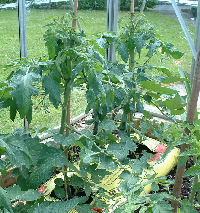
As the season advances remove yellowing leaves from the tomato plant. Some of the leaves may be removed from the growing plant just below the trusses of tomatoes as each truss ripens – don’t overdo this though as the leaves are there to manufacture food for the plant.
Pinch out the growing tip of the tomato plant when it reaches the roof, two leaves after the final truss… aim for no more than 7-8 trusses.
It may be tempting when learning how to grow tomatoes to try and set as many trusses of tomatoes as possible but try a resist this temptation. You are trying to achieve a happy compromise of quality and reasonable quantity that can be sustained with what you have available.
Water regularly to keep the compost moist. Hopefully by following my technique above, the potential for disappointment when using Growbags is gone. Regular watering is essential though – irregular watering will cause blossom end rot or fruit splitting.
Feed with a soluble, high potash tomato fertilizer once a week at least. All garden centres or large DIY stores will sell quite a wide choice of these.
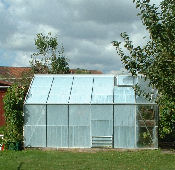
As summer progresses the sun gets stronger, so shade your tomato plants. If you don’t, greenback will occur – areas of the tomato will remain green and hard. In Britain Coolglass is ideal.
It is a ‘whitewash’ that can be sprayed or painted onto the glass of your greenhouse around the area where your plants will be affected by the strong sunlight. It does not get washed away by rain and is very effective. Come autumn it is easily scrubbed off.
Mist plants with a fine mist to help the fruit set and aid the dispersal of pollen. There are cheap and very effective garden hose spray attachments available with multi spray heads – they are perfect for this job.
How to Grow Tomatoes – Pest Control
Disease and disorders are much more important than insect pests. When first learning how to grow tomatoes, or any plant – dilligent observation is a good dscipline to acquire – you catch problems early.
Whitefly – the commonest of all the pests that affect tomato plants. The larvae and the adult both suck the sap from the leaves which become pale and curled. They secrete a sticky substance called honeydew – black mould then begins to grow causing even more disfigurement.
They look like small white moths which take short circular flights when disturbed.
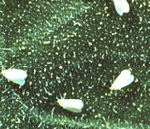
If there is a bad infestation spray with permethrin – a naturally occurring insecticide which does not harm humans or beneficial wildlife – every three days until brought under control. If the presence of whitefly is not serious try spraying with some diluted liquid detergent from the kitchen (a tea spoon to a litre of water) or purchase some predatory wasps called Encarsia Formosa.
The wasps can be set free in your greenhouse and will feast on your whitefly larvae along with any aphids present. Good garden centres should sell them.
It’s a grisly business learning how to grow tomatoes, is it not!
Aphids will colonise tomato plants so keep a diligent watch for their appearance. A serious infestation will badly stunt plant growth and even introduce virus problems.
Like whiteflies, they produce honeydew. Check over the leaves and stems of your vegetables, especially the tender growing tips… gently squish any colonies you find – gently for the plant that is.
Grow flowers like Tagetes or Marigolds in between rows to attract beneficial insects like hover flies and ladybirds which love to eat aphids. These insects are attracted to the easy access of the pollen, they then lay their eggs amongst the aphid colonies and when the little grubs hatch out – bon appetite… burp!
Try spraying with some diluted liquid detergent as mentioned above. A chemical spray may be required if the infestation becomes too serious. Pop into your local garden centre or nursery and ask their advice on what to use.
Blossom End Rot – Tough dark patches appear at the bottom end of the tomato fruit. This can be especially problematic with Growbags as the problem stems from irregular watering. There is no treatment but easily prevented by never letting the soil or compost dry out when the fruit is swelling.
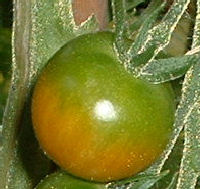
Greenback – an area of the tomato fruit around the stalk remains green, hard and unripe. Too much strong sunlight or too little potash is the cause.
Prevent by using Coolglass as explained above and make sure the greenhouse or poly tunnel is well ventilated. Again as explained above – liquid feed regularly with potash rich fertilizer. Resistant varieties are available.
How to Grow Tomatoes – Harvesting
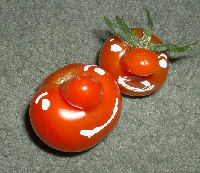
Pick your tomatoes as they ripen by snapping the stalk from the main stem and not pulling it away from the calyx (that small leafy area where the stalk enters the tomato fruit). The fruit will remain fresher for longer if the calyx remains attached.
At the end of the season lay unripe tomatoes in a tray and place them in a draw or cupboard with some bananas. Lots of the ripening gas ethylene is given off by the bananas and will help ripen the tomatoes.
Article source: https://www.vegetable-garden-guide.com/how-to-grow-tomatoes.html
SHARE IT SO OTHERS CAN FIND THE BEST GARDENING INFO


